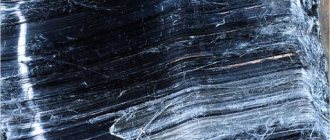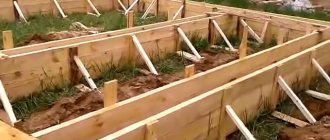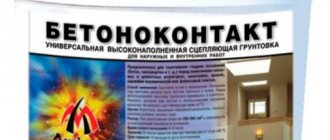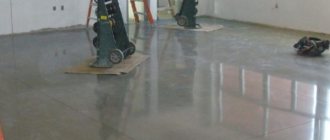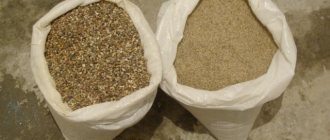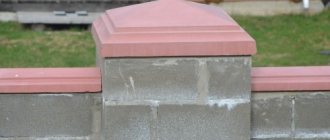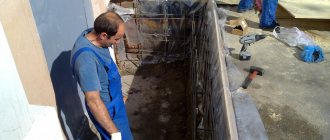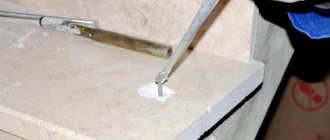The final stage of preparing the subfloor is often the installation of a concrete screed. Whether it is performed to level the surface or when pouring floors in a new building - it does not matter, the main thing is to achieve a solid foundation that will not crack over time under the influence of various factors. And, despite the strength of fully hardened concrete, there are quite a lot of them. These include temperature changes at which any material contracts or expands, soil shrinkage, etc. Any changes in volume entail a change in the coefficient of linear expansion. Moreover, if there is no gap between the screed and the adjacent walls, which would be able to compensate for the amount of expansion and minimize the pressure of concrete on the walls, the appearance of cracks is inevitable. Moreover, their appearance may not occur immediately after the screed has dried, but after some time, when you have already covered the concrete with the finishing coating. To avoid such troubles, which, by the way, may require additional and considerable costs to eliminate, a rather simple, one might even say primitive, but very effective remedy was invented, namely - damper tape for floor screed. In this article we will look at the main properties material, kinds tapes and popular class=”aligncenter” width=”620″ height=”525″[/img]
What is the material and its main purpose?
Damper or edge strips are made from polyethylene foam and are long strips, most often 5-15 cm wide. Building material of this type is sold in rolls. Damper tapes can have different thicknesses. Most often, when pouring screeds, compensation strips of 4-10 mm are used.
How to Simply Recommend
Why the medicine does not work The key to successful treatment is, of course, following all the doctor’s recommendations and informing him of all significant changes during therapy. However, a specialist can talk as much as he wants about the regimen and duration of taking the drug, but most patients will still violate these rules. Read more
The main feature of damper tapes is their softness and plasticity. This type of material compresses very easily under the influence of external force and also easily returns to its original shape. When pouring the screed, the tape is simply laid around the perimeter of the entire room, which allows you to create a shock-absorbing layer between the walls and concrete.
Materials, types, types
The polyethylene from which the damper tape is made can be uncrosslinked or crosslinked. Unstitched is cheaper, but less elastic, the walls can burst under significant load. Sewn is many times more expensive, but also more reliable. This explains the significant price difference that can be found for material of the same length/width/thickness. The type of material is indicated in the specifications. Also, the price depends on the density. This characteristic is not always indicated, but an indirect sign of higher density is greater mass. You just need to take into account the size of the tape.
What varieties are there?
Standard damper tapes are supplied to the market mainly in rolls from 10 to 20 m. Sometimes this type of material can be found on sale in rolls of 100 m. In fact, for screeds, rather narrow 10 cm tapes are usually used. Wider versions of this material by 15 cm are usually used only as a compensation material when installing various kinds of prefabricated concrete structures.
Manufacturers produce several types of damper tapes:
- standard;
- ribbons with a skirt;
- self-adhesive.
The standard material of this type is a regular long narrow strip of polyethylene foam. The ribbons with the skirt are complemented by a strip of oilcloth material. The skirt is attached in such a way that its edge protrudes beyond the edges of the ribbon itself. Such strips are mounted with the oilcloth facing down, so that the skirt extends to the floor surface. The advantage of this type of tape is that, in comparison with conventional ones, they provide better corner tightness.
Self-adhesive damper tapes differ from ordinary ones in that they have an adhesive strip on the back surface, covered with a protective layer. It is this type of material that is most often used when pouring screeds, since it is considered the most convenient to install. Indeed, in this case, you do not need to use any additional fasteners to install the tape. Sometimes manufacturers also apply an adhesive layer to ribbons with skirts.
Review of popular manufacturers and product prices
As you know, demand creates supply, and the higher it is, the easier it is to get confused in the variety of options. There are a very large number of manufacturers of damper tape. But despite this, there is still an option to purchase a low-quality product. Defects may include, for example:
- violation of the integrity of the tape;
- lag of the protective layer from the adhesive surface, which in the future will lead to the tape simply not sticking to the wall;
- the thickness of the strip can be different along the entire length;
- The bottom edge will be cut unevenly.
There are many nuances, especially often they appear on frankly cheap products. Therefore, it is better to purchase products from manufacturers that can be recommended by professional construction teams. For example:
The times when wooden slats, strips of linoleum, scraps of foam plastic or other available materials were used when arranging screeds for expansion joints along walls are gone. Today, damper tape for screed is used as a compensator for linear deformation of concrete.
When is it appropriate to use
The screed usually expands only when the temperature of the floor surface exceeds or equals the air temperature in the room. Therefore, for example, if insulation is laid on top of the screed on the first floor, the installation of a damper tape is considered optional. Indeed, in this case, the concrete itself will always remain cold. The insulation layer will not allow it to heat up.
The use of damper tape is considered mandatory when:
- pouring a concrete screed without insulation on top;
- arrangement of screed using the “warm floors” system;
- installation of floating floors;
- pouring blind areas around houses.
The surface temperature of the screed without insulation will vary greatly depending on the microclimate in the room itself. Consequently, the concrete in this case will expand from time to time. When using a “warm floor” system, the screeds become very hot. Accordingly, their expansion area will be very large.
The blind areas poured around houses become very hot in the sun in the summer. As a result, due to expansion, they begin to put pressure on the outside wall of the house and collapse.
How it can be used
When pouring concrete floors in city apartments and private houses, damper tapes are usually laid only around the perimeter of the premises. Indeed, in this case, the concrete expands evenly due to its small area.
When pouring concrete mortar for floors in very large rooms, for example, workshops or warehouses, this edging material is laid a little differently. In this case, the tape must also be laid around the perimeter, along the walls. But at the same time, several dividing strips are also made from it for the concrete surface itself. After all, a large screed can expand very unevenly in areas.
In not too large rooms, damper tape is also sometimes used to construct compensation bridges. But in this case it is used only when filling cannot be done in one cycle. Due to uneven water content, concrete layers poured at different times can also press on each other and collapse.
In buildings with complex layouts, damper tape can be laid not only around the perimeter of the walls, but also around columns, various types of supports, the soles of concrete stairs, etc. In addition, such edging material must be installed when pouring screeds around the foundations of stoves, fireplaces and boilers.
Laying
In order to correctly lay the damper tape around the perimeter of the room, you must first determine its required size. Taking into account the required multi-layer base, the optimal parameters of the strip are determined.
The following steps for fixing the damper tape and creating a high-quality screed must be performed in stages:
- Before attaching foamed polyethylene, the surface of the walls and floor must be cleaned of dust and construction debris.
- For better adhesion, it is advisable to treat the surface on which the tape is laid with a degreasing mixture and dry it.
- Work must be carried out at positive temperatures.
- The excess parts of the product are cut off, but if a plinth is subsequently installed on the floor, the excess parts of the edge strip can be left.
- If you are laying a tape with a skirt, it is important to ensure that this part is well covered with the building mixture.
- When installing a heated floor, tape is also needed. It must be laid between the heating systems and the vapor barrier layer or under it.
- Laying foamed polyethylene does not provide for voids. The room needs to be completely taped around the perimeter. It is also undesirable to make frequent joints from segments.
- After installation is complete, you can walk over the tape with a construction roller - it will remove minor flaws and additionally press the strip against the wall. Only after this stage can you start pouring the screed.
If the tape has an adhesive layer, then simply press it with the adhesive side against the wall along the entire perimeter of the room. The option with a “skirt” is folded onto the floor so that no liquid (moisture) can get under it.
There are alternative ways to attach the strip. These include:
- Furniture stapler. In the case where the walls of the structure are made of foam concrete, the tape is fixed with a stapler using metal staples.
- Self-tapping screws and hammer drill. Ideal mounting option for a brick wall. The screws are screwed directly into the wall. First, holes are created with a hammer drill, and then dowels and screws are inserted into them.
- Temporary fastening can be masking tape, which must be secured with PVA glue to walls that have been thoroughly cleaned of dirt. It is removed immediately before pouring the screed.
- Liquid Nails. Apply in those areas of the base where there are unevenness.
Do you need a damper tape for self-leveling floors?
Thus, edge compensation material is most often used when pouring concrete screeds. But floors in residential and industrial premises are leveled using not only cement mortar. Very often, more modern material is used for this purpose - various kinds of polymer compositions. And of course, many owners of apartments and country houses have a question about whether damper tape is needed for floors when using such fills.
According to SNiP, the use of damper tapes to compensate for seams is mandatory only for cement-containing mortars. When filling the floor with self-leveling polymer mixtures, it is not necessary to use such strips, according to the standards. Self-leveling floors are a contact material and do not expand too much during temperature fluctuations.
Advantages of the finished tape
Buffer tape does its job perfectly and has a lot of advantages. It is precisely due to the special properties of the material from which the tape is made that it cannot be fully replaced by other materials.
Correct application of the damper tape is a prerequisite when pouring the floor
Advantages of buffer tape:
- sufficient softness and plasticity to perform its functions - foamed polyethylene easily wrinkles and then restores its shape if necessary;
- excellent thermal insulation properties. This feature reduces heat leakage through the joints between walls;
- high sound insulation rate;
- environmental friendliness and complete safety for human health;
- the ability to provide waterproofing in installation areas;
- durability and strength of the material;
- ease;
- high resistance to external factors;
- complete resistance to biological factors - polyethylene does not rot, fungi and other parasites do not settle on it;
- very simple installation method.
Laying damper tape for floor screed
The only disadvantages of damper tape include its high cost. Using tape in repairs and construction can cause a serious blow to the budget. But, due to its advantages, this material is quite often used for repairing premises for various purposes - from residential to industrial. The damper tape does not have any negative reviews.
Self-adhesive damper tape
Damper tape for floor screed has a number of undoubted advantages compared to other materials (foam plastic, wood, linoleum) used for arranging expansion gaps. Its advantages are:
- high moisture resistance (an important indicator, since floor screed solutions contain a large amount of water);
- it is not susceptible to rotting, the formation of fungus and mold (especially important, since it remains in the screed in the form of an “unremovable” element);
- after mechanical impact, it restores its original geometric shape;
- durability;
- resistance to the aggressive influence of alkali included in screed solutions;
- immunity to temperature changes;
- low thermal conductivity;
- good sound insulation properties;
- resistance to ultraviolet radiation;
- environmental safety (intended for residential premises);
- high elasticity;
- ease of installation;
- a variety of sizes allows you to choose a ready-made tape for screed of any thickness;
- low price.
Due to its properties, damper tape is used not only as an expansion joint when installing screeds, but also for sealing gaps during various construction works.
How to lay the material
The width of the tape is chosen so that it subsequently protrudes above the surface of the screed by 1-2 cm. The actual technology for laying this material is as follows:
- Remove the protective film from the edge of the tape;
- press the material tightly against the wall in the corner;
- begin to unwind the roll, gradually removing the protective layer.
Using this simple technology, tape the bottom of the walls around the entire perimeter without joints. If the length of the strip is not enough for the entire room, an overlap of several centimeters is made at the joints.
Tapes without an adhesive layer are usually attached to the wall using self-tapping screws. In this case, plastic gaskets are used, purchased or cut, for example, from bottles. The use of gaskets in this case is mandatory. Without them, the material will be very easily damaged by self-tapping screws. The fasteners themselves for expansion tapes should only be used with large threads.
After the concrete has hardened, the protruding edge of the damper tape is cut off with a sharp construction knife. This procedure must, of course, be carried out only after the finishing screed has been poured.
What can be replaced
In general, damper tape is not the cheapest material. It is quite possible to find materials with the same properties, but cheaper. Without a skirt and an adhesive layer, but this is advanced functionality. If your budget is limited, you can replace the edge damper tape:
- polyethylene backing for the laminate, cut into strips of the required width;
- rubber band;
- old linoleum;
- penofol cut into strips.
If you fill the screed along the joists, a damper tape is also needed
There is another cheap option. Instead of damper tape, use thin wooden strips wrapped in plastic film. After the concrete has set, they are removed. A void can be left, or it can be filled.
How to fill the seam
In general, damper tape is a consumable material. That is, it is not removed from the screed and is not reused. But if you don't like the idea, you can delete it. And so that the gap does not fill with debris and insects do not live in it, it is filled with silicone sealant, which remains elastic after drying. But this option cannot be called cheap. The high consumption of expensive silicone makes savings irrelevant.
Buffer/damper/edge/edge floor tape for screed: how to install it
You can fill the gap with foam. Cut off the excess after hardening, but not to the level with the coating or screed, but a little deeper. Apply the same silicone on top. And the elasticity will remain, and there will be no gaps, and debris/insects will not annoy.
How and with what to cut
Most substitutes for damper tape are rolled materials. They can be cut into strips of the required width. If you need to be more or less careful, take a board, a sharp knife and a long ruler. Roll out the substrate, Izolon or other selected material. We lay a board under it along the edge. Place a ruler at the required distance from the edge and cut.
Ready for further work
To speed up the process, we fold the material in several layers, and then everything is the same. We put the board down, apply a ruler and cut along it. But we try to cut through all the layers at once down to the wood. It doesn't work out very nicely, but it's much faster.
Another way is to hang it with scissors. But this is not ideal at all, so you can do what is necessary. It’s also long and tedious, especially if you have to cut it for the whole apartment or house. The total is more than a hundred meters. So be patient. You can speed it up by sawing with a saw. If you are not a perfectionist, this is a great way.
How to make your own ribbon
Edge compensation material is sold in almost all construction supermarkets. So it won’t be difficult to purchase it at any time. However, the damper tape is, unfortunately, quite expensive. Therefore, many owners of apartments and private houses prefer to use homemade edge materials to compensate for the expansion of concrete.
The technology for making damper tapes with your own hands is relatively simple. You can make such an elastic strip, for example, from foil foam foam 10 mm thick. In order to cut a tape of the required width from a roll of such material, you can, for example, use a hacksaw with fine teeth. Also, sometimes penofol damper tapes are made using a battery-powered rectifier and nichrome thread. In this case, the strip is separated simply by melting without unwinding the roll.
At what height to trim
In general, the damper tape is needed for the screed, so you can safely cut it to the edge with the concrete slab. But the finishing materials laid on it also have thermal expansion. They are mounted with this in mind - leaving an empty space between the edge and the wall. This gap is usually 1 cm in size. So if you have a 10 mm thick edge installed, it does not need to be trimmed. In this case, the required technological gap will be maintained automatically.
The buffer tape for floor screed must be continuous
So, the damper tape can be cut flush with the concrete slab, or at the level of the finished floor, or not cut. What is not allowed is for it to be below the concrete level.
